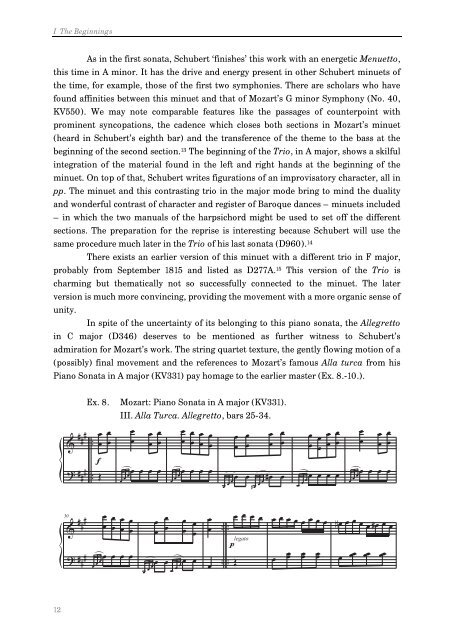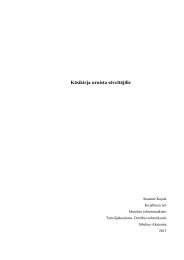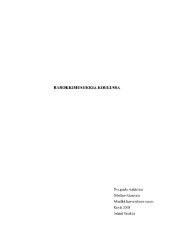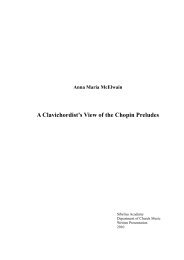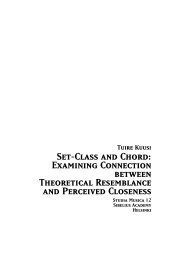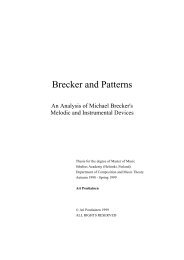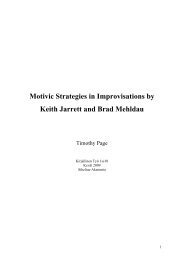The Unfinished Piano Sonatas of Franz Schubert Javier ... - Ethesis
The Unfinished Piano Sonatas of Franz Schubert Javier ... - Ethesis
The Unfinished Piano Sonatas of Franz Schubert Javier ... - Ethesis
Create successful ePaper yourself
Turn your PDF publications into a flip-book with our unique Google optimized e-Paper software.
I <strong>The</strong> Beginnings<br />
12<br />
As in the first sonata, <strong>Schubert</strong> ‘finishes’ this work with an energetic Menuetto,<br />
this time in A minor. It has the drive and energy present in other <strong>Schubert</strong> minuets <strong>of</strong><br />
the time, for example, those <strong>of</strong> the first two symphonies. <strong>The</strong>re are scholars who have<br />
found affinities between this minuet and that <strong>of</strong> Mozart’s G minor Symphony (No. 40,<br />
KV550). We may note comparable features like the passages <strong>of</strong> counterpoint with<br />
prominent syncopations, the cadence which closes both sections in Mozart’s minuet<br />
(heard in <strong>Schubert</strong>’s eighth bar) and the transference <strong>of</strong> the theme to the bass at the<br />
beginning <strong>of</strong> the second section. 13 <strong>The</strong> beginning <strong>of</strong> the Trio, in A major, shows a skilful<br />
integration <strong>of</strong> the material found in the left and right hands at the beginning <strong>of</strong> the<br />
minuet. On top <strong>of</strong> that, <strong>Schubert</strong> writes figurations <strong>of</strong> an improvisatory character, all in<br />
pp. <strong>The</strong> minuet and this contrasting trio in the major mode bring to mind the duality<br />
and wonderful contrast <strong>of</strong> character and register <strong>of</strong> Baroque dances – minuets included<br />
– in which the two manuals <strong>of</strong> the harpsichord might be used to set <strong>of</strong>f the different<br />
sections. <strong>The</strong> preparation for the reprise is interesting because <strong>Schubert</strong> will use the<br />
same procedure much later in the Trio <strong>of</strong> his last sonata (D960). 14<br />
<strong>The</strong>re exists an earlier version <strong>of</strong> this minuet with a different trio in F major,<br />
probably from September 1815 and listed as D277A. 15 This version <strong>of</strong> the Trio is<br />
charming but thematically not so successfully connected to the minuet. <strong>The</strong> later<br />
version is much more convincing, providing the movement with a more organic sense <strong>of</strong><br />
unity.<br />
In spite <strong>of</strong> the uncertainty <strong>of</strong> its belonging to this piano sonata, the Allegretto<br />
in C major (D346) deserves to be mentioned as further witness to <strong>Schubert</strong>’s<br />
admiration for Mozart’s work. <strong>The</strong> string quartet texture, the gently flowing motion <strong>of</strong> a<br />
(possibly) final movement and the references to Mozart’s famous Alla turca from his<br />
<strong>Piano</strong> Sonata in A major (KV331) pay homage to the earlier master (Ex. 8.-10.).<br />
Ex. 8. Mozart: <strong>Piano</strong> Sonata in A major (KV331).<br />
III. Alla Turca. Allegretto, bars 25-34.<br />
#<br />
& #<br />
#<br />
.<br />
œ<br />
œ<br />
? # #<br />
#<br />
.<br />
œ œ<br />
f<br />
Œ<br />
œ<br />
œ<br />
30<br />
# # œ œ œ œ<br />
& # œ œ œ œ<br />
? # #<br />
#<br />
œ œ œ œ<br />
œ<br />
œ<br />
œ<br />
œ<br />
œ œ œ<br />
œ œ œ œ<br />
œ<br />
œ<br />
œ<br />
œ<br />
œ<br />
œ<br />
œ<br />
œ<br />
œ œ œ œ œ œ œ<br />
œ œ œ œ<br />
œ<br />
œ<br />
œ<br />
œ<br />
œ<br />
œ œ<br />
œ œ œ œ œ œ œ<br />
œ<br />
œ<br />
œ<br />
œ<br />
œ<br />
œ<br />
œ<br />
œ<br />
œ<br />
œ<br />
œ œ œ œ œ # œ<br />
œ œ<br />
. .<br />
œ œ œ œ<br />
. .<br />
legato<br />
p<br />
Œ<br />
œ<br />
œ<br />
œ<br />
œ<br />
œ # œ<br />
œ<br />
œ œ œ<br />
œ<br />
œ œ œ<br />
œ œ œ œ<br />
œ<br />
œ<br />
œ<br />
œ œ œ œ œ œ œ œ<br />
œ<br />
œ œ œ<br />
œ<br />
œ<br />
œ<br />
œ œ œ<br />
œ œ œ œ<br />
œ<br />
œ<br />
œ<br />
# œ œ œ œ œ # œ œ œ<br />
œ<br />
œ<br />
œ<br />
œ<br />
œ<br />
œ<br />
œ


